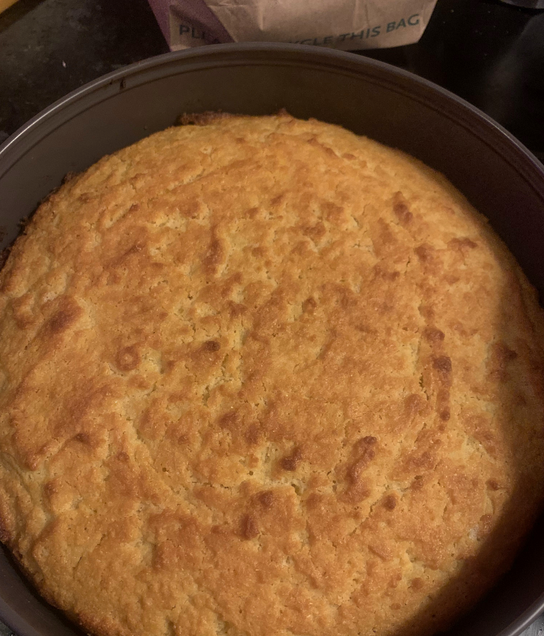Student Work Wednesday- Featuring Nicole Baker
This week we’re highlighting the work of Gastronomy student, Nicole Baker. Nicole completed a project in which she recreated a historical recipe for the Cookbooks and History course taught by Karen Metheny here at Boston University’s Metropolitan College.
Sutton’s Island’s Corn Cake of 1889
How does one recreate a recipe from 1889 with little to no information beyond the ingredients? Well for one, we start with what we know, which is experience in food, baking, and cooking, thankfully! The Sutton Island Cookbook is a compilation of recipes collected by someone working in the Sutton Island kitchen from the years 1889-1897. This island is a part of the Cranberry Isles off the coast of Mt. Desert Island, which is modern day Acadia National Park.
The majority of these recipes, themselves, are clippings from what seems to be a multitude of sources, but there is the occasional handwritten recipe sprinkled throughout. The compiler even notes that this cookbook is also seen as a scrapbook. Perhaps these recipes were ones they admired to make, enjoyed themselves, or with which they accommodated guests for meals on the island.
For this recipe recreation in our Cookbooks and History class, I chose the “Corn Cake” recipe on page 73 of the book (Fig 1). Since the recipe only lists ingredients, there was a lot of room for trial and error. Because of the absence of directions, I felt this recipe would be quite a journey to embark on, and perhaps bring me more confidence in my baking skills. While there was plenty of room for interpretation and trial, I did want to get this recipe right on the first go, so as not to waste ingredients.

For the technical aspect of baking this cake, I remembered from my own experience that most cakes today are baked between 350°F and 400°F. As a result, I chose a temperature within this range. Further, as we learned in class, during this period wood burning ovens were most common for baking and cooking. Thinking of this, I imagined there be some fluctuation in temperature as well, not quite staying an even 375°F or 400°F, hence, I chose 380°F as the cooking temperature.
From here, I went ahead and put everything together in a practical order, which I drew from my baking experience once again to do so. I started by creaming the sugar and butter by hand (since electric mixers may not have been used at the time, especially on an island in the north of Maine). I then added the rest of the wet ingredients to this mixture before slowly adding in the dry ingredients—flour, corn meal, cream of tartar and baking soda—and then letting the batter sit for about ten minutes. Lastly, I added the batter to a greased springform baking pan.
I baked the cake for about 35 minutes, starting with 15 minutes, checking it to find it still very raw, then continuing on with another twenty minutes. This time allowed for the cake to bake thoroughly, with the top coming out golden brown (Fig 2) and the bottom much darker, but not quite burnt. The edges were crispy and had some caramelization, but a little closer to burnt than the bottom reached. All in all, the cake had a good moisture level when consumed directly out of the oven and only dried out some overnight as tested by consuming another piece the following day.
The recipe proved to be successful thanks to my experience in baking and cooking. I am certain if I had not had this experience, reading through some of the other cake recipes in the book would have provided a good order of operations for mixing the ingredients, but I would have had to delve deeper into research for cooking temperatures and times.
One flaw I feel I made throughout this process was using a springform pan to back the cake. After a little research, I found that springform pans were first invented around 1919 by a German metal goods company known as Kaiser (Harte, 2023). With this information, it was definitely a historically inaccurate pan to use for this recipe, and something like a cast iron skillet would have been more accurate for the time. However, I didn’t think of this at the time.
All in all, the recipe turned out. I would call it good, and so might a few others that tried it, but some small improvements could make the cake more historically accurate if I tried this recipe, or another recipe from this book, again.

References:
Harte, Tom. (2023, Mar 27). A Harte Appetite: The Versatile Springform Pan. KRCU Public Radio. https://www.krcu.org/arts-culture/2023-03-27/a-harte-appetite-the-versatile-springform-pan. Accessed November 19, 2023.
Sutton Island (Maine) Cookbook, 1889-1897. B/S967. Schlesinger Library, Radcliffe Institute, Harvard University, Cambridge, Mass. https://id.lib.harvard.edu/ead/sch02223/catalog. Accessed November 19, 2023.